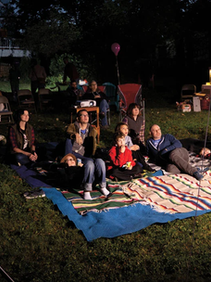Review: Longlegs - A Haunting Symphony of Horror that Transcends Genre Expectations
- Joao Nsita
- Aug 6, 2024
- 7 min read
Updated: Aug 14, 2024

In the ever-evolving landscape of horror cinema, Osgood Perkins' "Longlegs" emerges as a disquieting opus that defies easy categorization. This psychological thriller, starring Maika Monroe and featuring an almost unrecognizable Nicolas Cage, is a masterclass in atmospheric dread that lingers long after the credits roll. With its blend of occult mystique, serial killer intrigue, and a dash of Lynchian surrealism, "Longlegs" proves that in the right hands, familiar elements can coalesce into something truly unsettling and original.
Introduction: A Descent into Darkness
From its opening frames, "Longlegs" grabs you by the throat and doesn't let go. Perkins, known for his work on "The Blackcoat's Daughter" and "I Am the Pretty Thing That Lives in the House," demonstrates a keen understanding of what makes horror truly effective: it's not just what you see, but what you don't. Set against the perpetually gloomy backdrop of the Pacific Northwest in the 1990s, the film immediately establishes a sense of unease that permeates every frame.
Maika Monroe leads the cast as Lee Harker, a young FBI agent with an uncanny intuition that borders on the supernatural. Opposite her, lurking in the shadows, is Nicolas Cage as the titular Longlegs, a performance that will likely divide audiences but undeniably leaves an impression. With these pieces in place, Perkins crafts a narrative that is equal parts detective story and supernatural horror, challenging viewers to distinguish between the real and the imagined.
Plot Summary: Unraveling the Tapestry of Terror
The story of "Longlegs" unfolds like a fever dream, blurring the lines between reality and nightmare. Lee Harker, fresh-faced and determined, is assigned to a case that has baffled the FBI for decades. Families across the region have been systematically wiped out, with the patriarch inexplicably turning on his loved ones before taking his own life. The only clue left behind is a cryptic message signed "Longlegs," written in an indecipherable cipher.
As Lee delves deeper into the investigation, her unique abilities—a sort of psychic intuition that sets her apart from her colleagues—begin to manifest in increasingly unsettling ways. Partnered with the seasoned Agent Carter (Blair Underwood), Lee finds herself piecing together a puzzle that spans generations and seems to have roots in the occult.
The film's unique selling point lies in its ability to weave together elements of traditional police procedurals with supernatural horror. As Lee uncovers connections between the murders, ancient rituals, and her own mysterious past, the line between investigator and subject begins to blur. The introduction of cursed dolls and satanic undertones adds layers of complexity to what initially appears to be a straightforward serial killer hunt.
Nicolas Cage's Longlegs, when finally revealed in full, is a grotesque embodiment of otherworldly malevolence. Describing himself as a representative of "Mr. Downstairs," Cage's character serves as a conduit for forces beyond human comprehension, elevating the stakes from a mere cat-and-mouse game to a battle for Lee's very soul.
Director's Style and Cinematic Elements: A Masterclass in Atmosphere
Osgood Perkins' direction in "Longlegs" is nothing short of masterful. His approach to horror is decidedly old-school, relying more on atmosphere and suggestion than jump scares or graphic violence. The film's visual language is rich and unsettling, with Perkins employing a variety of techniques to keep the audience off-balance.
The cinematography, characterized by short lenses and slow zooms, creates a subtle distortion that pervades every frame. This visual unease is complemented by a high-contrast lighting scheme that bathes interiors in shadows, evoking comparisons to the works of David Lynch. The color palette, dominated by deep reds reminiscent of coagulated blood, further enhances the film's oppressive atmosphere.
Perkins' use of aspect ratios is particularly noteworthy. The film opens with a prologue shot in 4:3 with curved corners, mimicking an old photograph and immediately transporting viewers to a different time. As the narrative progresses, subtle shifts in aspect ratio serve as visual cues for flashbacks and changes in perspective, adding to the film's dreamlike quality.
The sound design and score by Zigli are integral to the film's success. Synthesizer-heavy compositions reminiscent of "The Shining" punctuate key moments, while the overall soundscape is a carefully orchestrated mix of unsettling ambient noises and dissonant tones that keep viewers on edge even in moments of apparent calm.
Themes and Deeper Meaning: The Horror Within and Without
While "Longlegs" operates primarily as a genre film, it touches on several themes that elevate it beyond mere entertainment. At its core, the film explores the nature of evil and the thin line between sanity and madness. Lee's journey into the heart of darkness serves as a metaphor for the human struggle to comprehend the incomprehensible.
The recurring motif of dolls and their connection to the occult speaks to themes of innocence corrupted and the malleability of the human psyche. These symbolic elements, combined with the film's 1990s setting, evoke the moral panics of the era and comment on society's tendency to seek supernatural explanations for human atrocities.
Furthermore, Lee's psychic abilities raise questions about the nature of perception and reality. As her visions become more intense and her connection to the case deepens, the film challenges viewers to question the reliability of their own senses and the nature of truth itself.

Acting Performances: Transformative and Nuanced
Maika Monroe continues to cement her status as a modern scream queen with her portrayal of Lee Harker. Her performance is a delicate balance of vulnerability and determination, bringing depth to a character that could easily have fallen into stereotype. Monroe's ability to convey complex emotions with subtle expressions adds layers to even the most effects-heavy scenes.
Nicolas Cage's performance as Longlegs is likely to be the film's most talked-about element. Hidden behind makeup that transforms him into a nightmarish blend of Ron Perlman's Beast and a demented mime, Cage fully commits to the role. His portrayal is equal parts terrifying and absurd, a high-wire act that somehow works within the film's carefully constructed tone.
The supporting cast, including Blair Underwood as Agent Carter and Alicia Witt as Lee's religiously fundamentalist mother, provide solid grounding for the more outlandish elements of the story. Their performances help to anchor the film in a sense of reality, making the supernatural elements all the more unsettling by contrast.
Strengths: A Unique Vision Realized
"Longlegs" excels in its ability to create and maintain a pervasive sense of dread. Perkins' command of tone and atmosphere is impeccable, crafting a world that feels consistently off-kilter and threatening. The film's visual and auditory elements work in perfect harmony to create a truly immersive horror experience.
The decision to keep Longlegs largely off-screen for much of the film's runtime is a strength, building anticipation and allowing viewers' imaginations to run wild. When the reveal finally comes, it's all the more impactful for the wait.
The film's blending of genres—police procedural, supernatural horror, and psychological thriller—keeps viewers engaged and guessing. By resisting easy categorization, "Longlegs" manages to subvert expectations and deliver genuine surprises.
Areas for Improvement: Pacing and Clarity
While "Longlegs" is largely successful in its aims, there are areas where it falters. The pacing in the middle section of the film can feel languid at times, potentially testing the patience of viewers expecting a more traditional horror experience.
Some plot elements, particularly the mechanics of Longlegs' kills and certain aspects of the occult backstory, remain frustratingly opaque. While this ambiguity contributes to the film's overall sense of unease, it may leave some viewers feeling unsatisfied.
Nicolas Cage's performance, while undeniably committed, may be divisive. For some, his more outlandish moments may break the carefully constructed atmosphere that Perkins has built.
Comparative Analysis: A Unique Entry in the Horror Pantheon
"Longlegs" draws clear inspiration from classic serial killer films like "The Silence of the Lambs" and "Seven," but its supernatural elements and focus on atmosphere set it apart. In its emphasis on mood over gore, it bears comparison to recent horror hits like "Hereditary" and "The Witch."
Within Perkins' own filmography, "Longlegs" represents a continued exploration of slow-burn horror and unreliable narrators. However, its more overt supernatural elements and larger scale mark an evolution in his directorial approach.
In the broader context of contemporary horror, "Longlegs" stands out for its commitment to building dread through cinematography and sound design rather than relying on jump scares or explicit violence.
Target Audience: For the Discerning Horror Fan
"Longlegs" is best suited for viewers who appreciate atmospheric horror and are willing to engage with a film that doesn't provide easy answers. It's not for the faint of heart, but neither is it a gore-fest. Ideal for fans of psychological thrillers and occult horror.
Personal Impact: A Lingering Unease
As someone who considers themselves well-versed in the horror genre, I found "Longlegs" to be a refreshingly unsettling experience. Days after viewing, certain images and sounds from the film continue to haunt me, a testament to Perkins' skill in crafting memorable horror.
The film's exploration of the thin line between intuition and madness resonated with me, prompting reflection on the nature of perception and the human capacity for both good and evil. While not without its flaws, "Longlegs" left me excited about the future of horror cinema and eager to see what Perkins does next.
Conclusion: A Chilling Addition to the Horror Canon
"Longlegs" is a film that demands attention and rewards close viewing. Osgood Perkins has crafted a uniquely unsettling experience that transcends genre conventions to deliver something truly memorable. While it may not be for everyone, those who surrender themselves to its dark charms will find a rich, atmospheric thriller that lingers long after the credits roll.
With its stellar performances, haunting visuals, and commitment to building genuine dread, "Longlegs" stands as one of the most compelling horror films of the year. It's a reminder that in the right hands, horror can be as thought-provoking as it is terrifying. As Lee Harker says in one of the film's more reflective moments,
"Sometimes the only way out is through." "Longlegs" takes us through the darkness, and we emerge changed on the other side.
For more inspiration on personal transformation, check out the Transform Your Life series at That Love Podcast and explore wellness tips at That Blissful Wellness Podcast.
For more movie reviews and cinematic insights, check out these articles:
Bad Boys: Ride or Die - An Explosively Fun Revival of the Buddy Cop Masterpiece
27 Dresses Review: The Delightfully Frothy Romantic Comedy Gem
IF: An Imaginative, Heartwarming Masterpiece That Will Leave You Spellbound
Inside Out 2: A Mind-Blowing Journey Through Adolescence That Will Leave You Emotionally Overwhelmed
The Proposal Review: A Refreshingly Charming Romantic Comedy Gem
Sleepless in Seattle Review: The Apex of Romantic Movie Magic
Love Actually: The Most Heartwarming Romantic Comedy of the 21st Century
For more movie reviews, ratings, and discussions, visit these trusted film resources:
Rotten Tomatoes | IMDb | Metacritic | Letterboxd | Criticker | MRQE | Roger Ebert | Film Comment | The Guardian - Film | AV Club - Film


























.jpg)
Comments